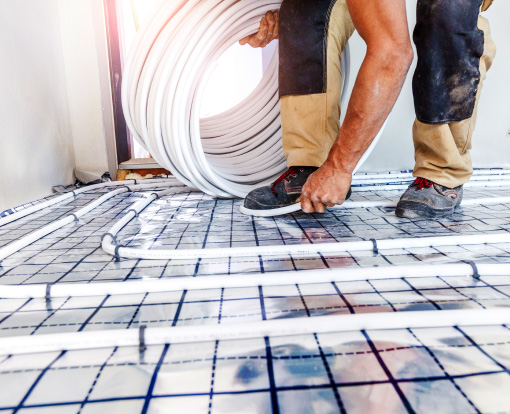Water Underfloor Heating
What is water underfloor heating?
Water underfloor heating systems (also known as wet or hydronic systems) use radiant heat technology to warm the objects and people in a room directly, as opposed to central heating which just heats the air of a room. This is a more sustainable way to heat your home and with increased energy-efficiency you can expect lower long-term running costs too.
Water systems pump gently heated water through underfloor heating pipes that are laid within, or on top, of the subfloor beneath your floor finish. These heating systems can be used with a range of heat sources such as a gas-fed boiler or heat pump, and are suitable for all types of homes.
 What are the benefits of a wet UFH system?
What are the benefits of a wet UFH system?
- Hydronic systems are much more sustainable than conventional heating options, preventing energy wastage and creating a more energy-conscious home.
- Floor heating offers lower running costs than central heating systems, due the lower temperatures required, but still produce the same level of warmth.
- Water floor heating systems are ideal for new-build projects or larger refurbishments where they can operate as the primary heat source for the whole space.
- Wet systems require little-to-no maintenance and will ensure your home is always the right temperature.
- Radiant heat is much better for the air quality of the room, keeping it fresher than rooms using radiators and removing the problem of dust circulation.
- Underfloor heating systems allow design freedom, with no need for radiators you will have more wall space and won’t have to compromise on style.
What projects are wet systems suitable for?
Water systems are typically recommended for new-build projects where the system will be the primary source of heat. Many of these systems require installation within a thick layer of screed, leading to a greater system depth compared to electric heaters. This should be taken into account when developing your architectural blueprints. Low-profile wet systems are perfect for use in single-room or smaller renovation projects. You can use water UFH with all floor coverings and subfloor types.
How do I control a floor heating system?
Underfloor heating thermostats offer zoned heating control, meaning you can heat specific areas of your home as desired. Thermostats allow you to set custom heating schedules and ensure your system is running more efficiency.
There are a range of smart controls available that allow you to control your wet system remotely with your mobile device. Using a smart thermostat with your underfloor heating system can save you hundreds of pounds on your annual energy bills. Having mobile control over your heating system allows you to control the temperature and functionality with ease.
How do I install wet underfloor heating?
Water underfloor heating systems generally require a more labour-intensive installation than electric systems, so these should always be installed by a fully qualified tradesperson. A key element to look for when selecting a system is whether it requires a ‘wet’ or ‘dry’ installation method. ‘Wet’ installation means the system will need to be installed within a layer of concrete screed, and ‘dry’ meaning it will not.
It is recommended to carry out a heat loss calculation before starting your project if you plan to use the system as a primary heat source. Ensuring you use insulation materials with your installation will assist with heat loss prevention.